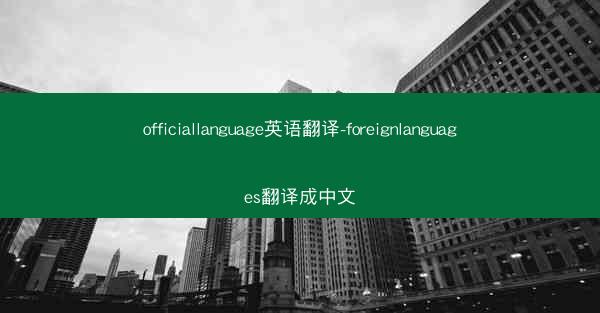officiallanguage英语翻译-foreignlanguages翻译成中文

Title: The Art and Science of Official Language English Translation to Chinese
Introduction:
In the globalized world we live in today, language acts as a bridge that connects cultures and facilitates communication. One of the most significant aspects of this linguistic bridge is the translation of official languages, with English being a prime example. This article delves into the intricacies of translating official language English into Chinese, aiming to pique the interest of readers and provide them with a comprehensive understanding of this complex process.
Historical Context
The translation of official language English to Chinese has a rich historical background. With the expansion of British colonialism in the 19th century, English became a lingua franca in many parts of the world, including China. This led to the need for translating official documents, literature, and scientific works from English to Chinese. Over the years, the demand for accurate and culturally sensitive translations has grown, reflecting the increasing importance of English as a global language.
Cultural Sensitivity
One of the key challenges in translating official language English to Chinese is maintaining cultural sensitivity. Translators must be aware of the cultural nuances and idiomatic expressions to ensure that the translated text resonates with the target audience. For instance, a phrase that is acceptable in English might be considered offensive or inappropriate in Chinese culture. This requires a deep understanding of both languages and cultures.
Technical Terminology
Technical terminology poses a significant challenge in translation. Many scientific, legal, and medical terms have no direct equivalent in Chinese, necessitating the creation of new terms or the adaptation of existing ones. Translators must collaborate with subject matter experts to ensure accuracy and consistency in technical translations.
Legal and Regulatory Compliance
Translating official language English to Chinese also involves adhering to legal and regulatory standards. This is particularly crucial in legal documents, where the accuracy of the translation can have significant implications. Translators must be well-versed in both the legal systems of the source and target languages to ensure compliance.
Language Evolution
Language is dynamic, and both English and Chinese are constantly evolving. Translators must stay updated with the latest trends and changes in both languages to ensure that their translations remain relevant and accurate. This includes understanding new slang, idioms, and technical terms that emerge over time.
Technology and Tools
Advancements in technology have revolutionized the translation process. Tools like machine translation and translation memory software have made it easier and faster to translate large volumes of text. However, these tools are not foolproof and require human intervention to ensure quality and accuracy.
Quality Assurance
Ensuring the quality of translations is a critical aspect of the process. This involves rigorous editing, proofreading, and quality control measures to eliminate errors and inconsistencies. Professional translators often work in teams to ensure that the final product meets the highest standards.
Training and Education
The field of translation requires specialized training and education. Translators must have a strong command of both English and Chinese, as well as a solid understanding of the cultural and linguistic nuances of both languages. Many translators pursue advanced degrees in translation studies or related fields to enhance their skills.
Conclusion:
The translation of official language English to Chinese is a complex and multifaceted process that requires a deep understanding of both languages and cultures. By addressing the challenges and embracing the opportunities presented by this field, translators can contribute to the global exchange of ideas and knowledge. As the importance of English continues to grow, the demand for accurate and culturally sensitive translations will only increase. This article has highlighted the key aspects of this process, emphasizing the importance of cultural sensitivity, technical expertise, and quality assurance. Future research should focus on exploring new technologies and methodologies to further improve the translation process and meet the evolving needs of the global community.
